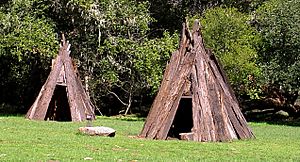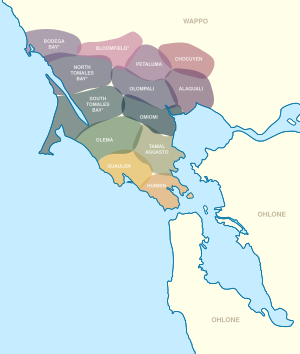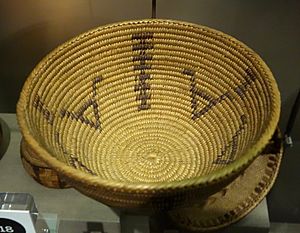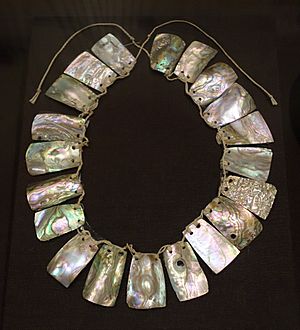Coast Miwok facts for kids

Modern reconstructions of Coast Miwok shelters at Kule Loklo
|
|
| Total population | |
|---|---|
| 1770: 2,000 1850: 250 1880: 60 2000: 167 |
|
| Regions with significant populations | |
| California: Sonoma County |
|
| Languages | |
| Utian: Coast Miwok |
|
| Religion | |
| Shamanism: Kuksu: Miwok mythology |
|
| Related ethnic groups | |
| Miwok Plains & Sierra Miwok |
The Coast Miwok are an Indigenous people who traditionally lived in the beautiful coastal areas of what is now Northern California. They were the second-largest group among the larger Miwok people. Their homeland stretched across present-day Marin County and southern Sonoma County. This area extended from the Golden Gate north to Duncans Point and east toward Sonoma Creek.
The Coast Miwok were made up of several local groups, sometimes called tribelets. These included the Olamentko near Bodega Bay and the Huukuiko in Marin County. They did not have one single name for themselves. The word Miwok itself comes from a related language and means 'people'.
Contents
Coast Miwok Culture and Daily Life
The Coast Miwok spoke the Coast Miwok language, which belongs to the Utian language family. They lived as hunters and gatherers. They organized themselves into small groups without a single central government.
Food Sources and Hunting Traditions
Their diet changed with the seasons. In the spring, they moved toward the coasts and bays to hunt salmon and gather seafood, including shellfish and seaweed.
The main staple food was the acorn, especially from black and tan oak trees. They also gathered nuts and hunted wild game. Key animals hunted included deer, especially the black-tailed deer, and cottontail rabbits.
When hunting deer, Miwok hunters used plants like Brewer's angelica to hide their human scent. They generally avoided hunting bears.
Traditional Homes and Crafts
Traditional Coast Miwok houses were called kotcha. They were built in a cone shape using slabs of tule grass or redwood bark.
The Miwok people were highly skilled at basket weaving. They used various plant fibers to create beautiful and useful baskets.
Tattooing was a traditional practice. They used pigment made by burning poison oak for their designs.
A reconstructed Coast Miwok village called Kule Loklo can be visited today at the Point Reyes National Seashore.
Understanding Coast Miwok Plant Knowledge
The Coast Miwok had deep knowledge about the plants in their environment. They used local flora for food, medicine, tools, and spiritual purposes.
Plants for Health and Healing
They used many plants as natural medicine. For example, they used Willow for pain relief, similar to modern aspirin. Blue Elderberry was used for respiratory issues and skin treatments. Yerba Buena tea leaves were also used medicinally.
Plants for Food Sustenance
The Miwok actively managed their environment to ensure food sources lasted. They collected, stored, and planted seeds. They also used controlled burns and managed oak groves to encourage acorn production.
Acorns were crucial, coming from trees like Black Oak and Coast Live Oak. They also ate various berries (like Wild Strawberry and Huckleberry) and bulbs (like Wild onion and Mariposa lily).
Plants for Technology and Tools
Plants were essential for building shelter and making tools. Redwood bark was used for building homes. Tule reeds were used to make canoes for travel on the water.
They used strong woods like Pacific Yew for making bows for hunting. Plant fibers from Milkweed and Dogbane were used to make strong ropes and cords. They used specific ferns with black stems for decorative elements in basket weaving.
Beliefs and Mythology
The Coast Miwok believed in animism, meaning they saw spirits in animals and nature. Their spiritual practices included the Kuksu religion, which was common among many Central California tribes.
Kuksu involved special ceremonies, dances in traditional costumes, and annual mourning rituals. These ceremonies often took place in underground dance rooms.
Coast Miwok mythology taught that animal spirits were their ancestors. Coyote was a central figure, seen as both an ancestor and the creator god. Their stories describe the Earth beginning when land formed out of the Pacific Ocean.
Coast Miwok Villages
The Coast Miwok lived in many villages across their territory. Some of the authenticated villages include:
- On Bodega Bay: Helapattai, Ho-takala, Tokau.
- On Tomales Bay: Echa-kolum, Utumia (near Tomales).
- Near Petaluma: Etem, Petaluma, Susuli.
- Near San Rafael: Awani-wi.
- Near Novato: Chokeche, Olompolli.
Coast Miwok History and Resilience
The Coast Miwok people have lived in this region for a very long time. Archaeological evidence, such as ancient charmstones and arrowheads found at Tolay Lake, suggests continuous occupation dating back 4,000 years. Tolay Lake was considered a sacred site for ceremonies and healing.
Coastal groups like the Coast Miwok were likely among the first people to settle on the North American continent.
Early European Contact
The first documented contact with Europeans dates back to 1579, when a priest on Sir Francis Drake's ship recorded meeting Californian natives. Later, Spanish and Russian voyagers also documented their presence between 1595 and 1808.
The Mission Period and Population Decline
Starting in the late 1700s, the lives of the Coast Miwok changed drastically with the arrival of the Spanish missions. Many Coast Miwok individuals were moved to Mission San Francisco de Asis (Mission Dolores) beginning in 1783.
In 1817, Mission San Rafael was founded in Coast Miwok territory. Spanish authorities moved many Coast Miwok people who had been at other missions back north to help establish Mission San Rafael. By the end of 1817, about 850 Coast Miwok people had been converted to Christianity.
During this period, the Coast Miwok population suffered greatly. Diseases introduced by Europeans, such as smallpox, caused a massive decline in their numbers.
Life After the Missions
When the Mission period ended (1834), the mission lands were taken over by Mexican settlers (Californios). Many Coast Miwok people were forced to work on these large farms, called ranchos, often in conditions of servitude. They were essential workers because they had the skills needed for farming and ranching.
Some Miwok leaders tried to secure land for their people. Camilo Ynitia, a Coast Miwok leader, secured a large land grant called Rancho Olompali in 1843. This land included his home village of Olompali, which was an important center dating back to 500 AD. Although Ynitia eventually had to sell most of the land, he ensured a portion remained for his family.
Another area where Miwok people lived independently was Rancho Nicasio. However, over time, most of this land was also lost due to illegal confiscation by settlers.
By the time California became a state in 1850, many Miwok families worked as farm laborers or fishermen in their traditional homelands, often moving seasonally for work.
Modern Recognition
Today, the descendants of the Coast Miwok and Southern Pomo people are recognized federally as the Federated Indians of Graton Rancheria. They achieved this official tribal status in December 2000, continuing the legacy and culture of their ancestors.
Notable Coast Miwok Figures
- Camilo Ynitia (1816–1856): A key Coast Miwok leader who secured the Rancho Olompali land grant for his people.
- Chief Marin: A Coast Miwok leader from the Huimen tribelet. He was an important figure at Mission San Rafael in the 1820s. Marin County is named in his honor.
- Quintin: Known as the sub-chief of Marin. The San Quentin Peninsula is reputed to be named after him.
- Greg Sarris: The current Tribal Chairman of the Federated Indians of Graton Rancheria, also a respected college professor and author.
- Julia F. Parker: A highly regarded basket weaver.
Population Estimates
Historians estimate that around 2,000 Coast Miwok people lived in the area in 1770, before extensive European contact. This number dropped sharply due to disease and conflict. By 1850, the population was estimated at only 300, and by 1880, it was around 60. Today, their descendants continue to thrive as part of the federally recognized tribe.
Images for kids
See Also
- Marin Museum of the American Indian, located on a former Coast Miwok settlement site.
- Fully feathered basket






